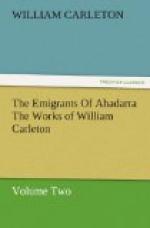the cave, and fixed upon a large turf fire which burned
within a circle of stones that supported it, was a
tolerably-sized Still, made of block-tin. The
mouth of this Still was closed by an air-tight cover,
also of tin, called the Head, from which a tube of
the same metal projected into a large keeve, or condenser,
that was kept always filled with cool water by an
incessant stream from the cascade we have described,
which always ran into and overflowed it. The
arm of this head was fitted and made air-tight, also,
into a spiral tube of copper, called the Worm, which
rested in the water of the cooler; and as it consisted
of several convolutions, like a cork-screw, its office
was to condense the hot vapor which was transmitted
to it from the glowing Still into that description
of spirits known as poteen. At the bottom of
this cooler, the Worm terminated in a small cock or
spigot, from which the spirits projected in a slender
stream, about the thickness of a quill, into a vessel
placed for its reception. Such was the position
of the Still, Head, and Worm, when in full operation.
Fixed about the cave, upon rude stone stillions, were
the usual vessels requisite for the various processes
through which it was necessary to put the malt, before
the wort, which is its first liquid shape, was fermented,
cleared off, and thrown into the Still to be singled;
for our readers must know that distillation is a double
process, the first product being called singlings,
and the second or last, doublings—which
is the perfect liquor. Sacks of malt, empty vessels,
piles of turf, heaps of grains, tubs of wash, and
kegs of whiskey, were lying about in all directions,
together with pots, pans, wooden trenchers, and dishes,
for culinary uses. The seats were round stones
and black bosses which were made of a light hard moss
found in the mountains and bogs, and frequently used
as seats in rustic chimney corners. On entering,
your nose was assailed by such a mingled stench of
warm grains, sour barm, putrid potato skins, and strong
whiskey, as required considerable fortitude to bear
without very unequivocal tokens of disgust.
The persons assembled were in every way worthy of
the place and its dependencies. Seated fronting
the fire was our friend Teddy Phats, which was the
only name he was ever known by, his wild, beetle brows
lit into a red, frightful glare of savage mirth that
seemed incapable, in its highest glee, to disengage
itself entirely from an expression of the man’s
unquenchable ferocity. Opposite to him sat a tall,
smut-faced, truculent-looking young fellow, with two
piercing eyes and a pair of grim brows, which, when
taken into conjunction with a hard, unfeeling mouth,
from the corners of which two right lines ran down
his chin, giving that part of his face a most dismal
expression, constituted a countenance that matched
exceedingly well with the visage of Teddy Phats.
This worthy gentleman was a tinker, and one of Hogan’s
brothers, whom we have already introduced to our readers.




